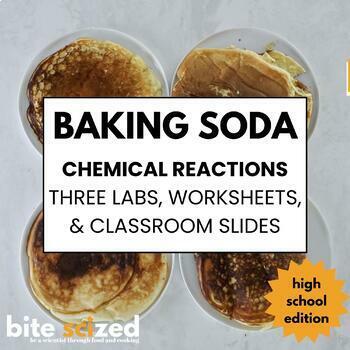Baking Soda Lab & Lesson Plan: 9-12 [chemical reactions and limiting reactants]
Grade Levels
9th - 12th
Subjects
Resource Type
Standards
NGSSHS-PS1-7
NGSSHS-PS1-2
Formats Included
- Google Drive™ folder
Pages
30 pages

Made for Google Drive™
This resource can be used by students on Google Drive or Google Classroom. To access this resource, you’ll need to allow TPT to add it to your Google Drive. See our FAQ and Privacy Policy for more information.
Description
In this 3-7 day lesson, students complete multiple labs and explore the chemical reaction behind baking soda in pancakes and the importance of ratios in chemical reactions.
This Lesson Includes:
- Teacher Lesson Plan with Essential Questions, Objectives, and NGSS standards, Lab Preparation (Materials, Ingredients, Amazon Lists when appropriate, and Tips & Tricks) and day-by-day lesson plans
- Classroom Slides with directions for lesson flow, turn and talk prompts, illustrations and graphics, embedded videos, and whole group reflection questions
- Student Handouts with step-by-step lab directions and other activities
- Infographic that explains key concepts
- Videos: an instructional lab video and a fun and informative Science Behind video about Baking Soda and Pancakes
Students will learn about chemical reactions, atoms & elements, limiting reactants, theoretical yield, and percent yield.
All materials are included in the Google Drive folder
Total Pages
30 pages
Answer Key
N/A
Teaching Duration
1 Week
Report this resource to TPT
Reported resources will be reviewed by our team. Report this resource to let us know if this resource violates TPT’s content guidelines.
Standards
to see state-specific standards (only available in the US).
NGSSHS-PS1-7
Use mathematical representations to support the claim that atoms, and therefore mass, are conserved during a chemical reaction. Emphasis is on using mathematical ideas to communicate the proportional relationships between masses of atoms in the reactants and the products, and the translation of these relationships to the macroscopic scale using the mole as the conversion from the atomic to the macroscopic scale. Emphasis is on assessing students’ use of mathematical thinking and not on memorization and rote application of problem-solving techniques. Assessment does not include complex chemical reactions.
NGSSHS-PS1-2
Construct and revise an explanation for the outcome of a simple chemical reaction based on the outermost electron states of atoms, trends in the periodic table, and knowledge of the patterns of chemical properties. Examples of chemical reactions could include the reaction of sodium and chlorine, of carbon and oxygen, or of carbon and hydrogen. Assessment is limited to chemical reactions involving main group elements and combustion reactions.




